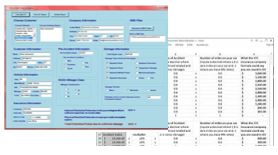Do your sales teams have value calculators? If so, when do they use them?
Value calculators are vital to sales teams, because buyers do the math. A CFO Magazine  survey of Buyer Executives found that over 90% of enterprise buyers involve their finance teams in selecting vendors, developing business requirements, and preparing/reviewing the financial justification for buying decisions. A quantitative business case, as part of the B2B buying process, is the rule, not the exception.
survey of Buyer Executives found that over 90% of enterprise buyers involve their finance teams in selecting vendors, developing business requirements, and preparing/reviewing the financial justification for buying decisions. A quantitative business case, as part of the B2B buying process, is the rule, not the exception.
When a customer sponsor starts to build the internal business case, the average unarmed sales rep reacts by trying to stay in the loop to keep the internal business case from heading off the rails. The best sales reps take proactive steps to support customer sponsors, helping them to build a shared business case to buy. They make sure they prepare for customer conversations with a plan to drive the buyer’s math in the right direction. This often results in a sales team fire drill as someone scrambles to pull together a last minute spreadsheet.
 It doesn’t take too many emergency spreadsheets for product managers to realize that eleventh hour analyses don’t scale effectively or efficiently. They begin to anticipate the need for a quantitative business case by creating value calculators and broadly applicable spreadsheets to make sales teams more effective in having the value conversation. The result is a proliferation of value calculators that often fail to distinguish themselves in already large sales toolboxes.
It doesn’t take too many emergency spreadsheets for product managers to realize that eleventh hour analyses don’t scale effectively or efficiently. They begin to anticipate the need for a quantitative business case by creating value calculators and broadly applicable spreadsheets to make sales teams more effective in having the value conversation. The result is a proliferation of value calculators that often fail to distinguish themselves in already large sales toolboxes.
The Problem with Value Calculators. Value calculators designed for the end of the sales cycle can be useful in achieving higher prices, but they rarely get the use and traction that they should. Too often, they are cobbled together based on a poorly designed spreadsheet and are designed to play defense rather than offense. There are two fundamental design flaws that are common to value calculators for B2B sales:
- Too much discovery required. Value calculators targeted toward a late-in-the-sales-
 cycle need for a business case often require extensive customer-specific information and discovery. It should surprise no one if these discovery-heavy tools (i) are used primarily by subject matter experts,
cycle need for a business case often require extensive customer-specific information and discovery. It should surprise no one if these discovery-heavy tools (i) are used primarily by subject matter experts,  solution consultants and other presales professionals, and (ii) are only used late in the sales cycle.
solution consultants and other presales professionals, and (ii) are only used late in the sales cycle.
Value calculators with a detailed list of questions to be answered are unlikely to be used by sales reps and will rarely be used early in the sales cycle.
- For sales reps looking to increase the number of qualified opportunities at the top of the funnel, their scarcest resource is time. They view tracking down a long list of customer data as unproductive. Those brief windows where they get live customer engagement are too valuable for sales to risk the distraction of filling out a questionnaire with the customer on the line. Too much discovery required in a value calculator is a recipe for limited sales use early in the sales cycle.
- Even if a rep is willing to pursue a list of discovery questions early, most prospects are unlikely to be patient or forthcoming in their answers. Early in the buying process, potential buyers are also trying to spend time efficiently. They are rarely interested in providing information that they may view as sensitive before they have decided to evaluate a product or a solution.
Extensive discovery requirements built into a value calculator limit the scope of how, when and by whom the value calculator will be used.  Insufficient marketing design. Product managers building late-in-the-sales-cycle value calculators often neglect the fundamentals of marketing in designing their sales tools. The result is often an overly analytical calculator or spreadsheet rather than a core piece of marketing content.
Insufficient marketing design. Product managers building late-in-the-sales-cycle value calculators often neglect the fundamentals of marketing in designing their sales tools. The result is often an overly analytical calculator or spreadsheet rather than a core piece of marketing content.
There are several factors that can contribute to this failure. Product managers may not ask for enough input from marketing because quantitative value content seems too technical to get marketing communications professionals involved. Product managers may not apply enough attention and marketing bandwidth of their own in considering how the calculator works, how it is laid out or how it embeds central qualitative marketing messages. As long as their perspective is that value calculators are for reactive use late in the sales cycle, primarily by presales, marketing efforts and elements often seem less important in designing the content and usefulness of the material.
The result is predictable: value calculators that are not ready for prime time in front of customers. Too often, value calculators are overly complicated, look like spreadsheets, lack integrated product messaging and are not visually helpful or appealing.
Get More Out of your Value Calculators: Set a Better Objective. There is a simple way to get more out of your value calculators. Reset the bar. Change the goal. As long as management’s objective is to come up with a “value calculator”, a complicated spreadsheet is likely to be the result. Instead set your team’s objective as a “Value Proposition” or, even better, as a “Flexible Case Study.”
“Value Propositions” come in many forms, qualitative and quantitative, but most marketing professionals understand that a “Value Proposition” should make a few clear, memorable points about the two or three things you do better than the competition and what that is worth. Turning a value calculator into a Value Proposition implies focusing less on answers and math and more on differentiation and what you do for your customer.
When management says, “we need a Value Proposition, not just a value calculator,” it provides clear direction that helps reorient teams toward concrete messages about differentiation as a primary objective of the sales tool. Setting an objective of making the Value Proposition useful in early sales conversations raises the bar. It encourages teams to go beyond calculators that merely regurgitate calculated answers. A Value Proposition is a tool that can be used earlier in the sales process by both sales and presales to make memorable qualitative and quantitative points about how you are different and how you are better.
A further, sometimes transformative, step is to set an objective of making value calculators into “Flexible Case Studies.” A case study is often the single best piece of content or collateral that product management and marketing teams make available to sales. A case study, whether specifically naming a customer or keeping the customer anonymous, provides concrete information about what you did for a customer and the benefits of your product or solution to that customer.
Good case studies invite a sales rep to tell a story. Case studies are useful early in the sales cycle with typical (not specific) customer data. A case study can be a subtle, natural way for a sales rep to help a customer understand quickly and persuasively how your solution is better and how that benefits the customer. Case studies can help change the focus of customer conversations from product-centric to customer-centric. This helps sales connect with the customer and get the right next meeting.
Making Case Studies Flexible. In practice, the typical case study delivered by marketing to a customer’s already crowded inbox rarely fulfills its potential as a sales tool. The content of a case study should be an ideal way to highlight the connection between your solution and your customer in a conversation.
 Yet all too often, a case study is formatted as a static pdf that a rep attaches to an email as a follow-up or as part of a lead nurturing strategy. The result is that many case studies have the look and feel of historical documents that describe what has already happened without supporting a conversation about the future. This limits their use and usability in direct prospect discussions and presentations. These case studies are not flexible or dynamic enough. They typically start with the specifics of one customer and lack the adaptability that would make them more relevant to a new prospect.
Yet all too often, a case study is formatted as a static pdf that a rep attaches to an email as a follow-up or as part of a lead nurturing strategy. The result is that many case studies have the look and feel of historical documents that describe what has already happened without supporting a conversation about the future. This limits their use and usability in direct prospect discussions and presentations. These case studies are not flexible or dynamic enough. They typically start with the specifics of one customer and lack the adaptability that would make them more relevant to a new prospect.
Embedding calculator functionality into a dynamic case study helps to make the case study more flexible and more useful. If a few key assumptions of the case study are laid out clearly and if calculator functionality is embedded, the case study can become a tool that can be used early in the sales cycle, inviting the customer to talk about their business and their problems.
When prospects identify with a relevant case study, they see the connection between their  problems and your solution. When prospects engage in a case study conversation about how your solution created value for another customer, their confidence in your ability to deliver for them increases. When prospects indicate that a problem solved for another customer applies to them, it helps a sales rep to qualify the account and steer the conversation toward topics that matter specifically to the prospect. If the case study problems that your solution solves don’t apply to or resonate with a prospect, that is a good reason for the sales rep to spend less time on the account.
problems and your solution. When prospects engage in a case study conversation about how your solution created value for another customer, their confidence in your ability to deliver for them increases. When prospects indicate that a problem solved for another customer applies to them, it helps a sales rep to qualify the account and steer the conversation toward topics that matter specifically to the prospect. If the case study problems that your solution solves don’t apply to or resonate with a prospect, that is a good reason for the sales rep to spend less time on the account.
Well Designed Value Propositions. CRM data from organizations adopting value selling show that opportunities where a Value Proposition is used (1) have 5-15% higher win rates and (2) 5-25% higher price outcomes. There is good reason to make the investment of time and bandwidth in designing good Value Propositions. Value Propositions are a tool for use by sales teams in call preparation, customer conversations and presentations to customer teams. They can be designed with users in mind where increasingly customer-facing teams include both sales representatives and presales professionals.
A great Value Proposition has the flexibility to transition gradually and continuously through the sales cycle. Starting as a Flexible Case Study, a Value Proposition is a tool that can be used with typical customer data in early sales conversations. Gradually customer specifics are  revealed and unfold through customer interaction and become embedded in the Value Proposition as it provides a basis for Customer Value Analysis and presales customization as customers evaluate your solution. As customers decide to purchase, the Value Proposition becomes a Shared Business Case, collaboratively agreed between sales executives and customer sponsors, that can be used by buyers as their own internal financial justification to purchase.
revealed and unfold through customer interaction and become embedded in the Value Proposition as it provides a basis for Customer Value Analysis and presales customization as customers evaluate your solution. As customers decide to purchase, the Value Proposition becomes a Shared Business Case, collaboratively agreed between sales executives and customer sponsors, that can be used by buyers as their own internal financial justification to purchase.
Increasingly, the best B2B teams use Value Propositions collaboratively to improve B2B sales team performance, addressing sales challenges throughout the B2B sales cycle. For account  executives and sales reps, they are useful early in the sales cycle as Flexible Case Studies in call preparation, in building sales confidence, in qualifying opportunities and in engaging customer executives. For technical sales and presales professionals, joining a customer-facing team in the middle of the sales process, Value Propositions provide Customer Value Analysis as an important way to address presales challenges and to maximize the impact of presales. Sales and presales teams, working together, use Value Propositions to highlight differentiation and cut through complexity as they collaborate with customer stakeholders to build a shared business case to buy. That Shared Business Case can be used to accelerate the closing process.
executives and sales reps, they are useful early in the sales cycle as Flexible Case Studies in call preparation, in building sales confidence, in qualifying opportunities and in engaging customer executives. For technical sales and presales professionals, joining a customer-facing team in the middle of the sales process, Value Propositions provide Customer Value Analysis as an important way to address presales challenges and to maximize the impact of presales. Sales and presales teams, working together, use Value Propositions to highlight differentiation and cut through complexity as they collaborate with customer stakeholders to build a shared business case to buy. That Shared Business Case can be used to accelerate the closing process.
Value Propositions are an improvement on value calculators. Value Propositions are about more than getting the math right. They provide central content that helps sales teams communicate what your solution does for your customers. Value Propositions are a shared basis for sales collaboration that help sales teams win.

